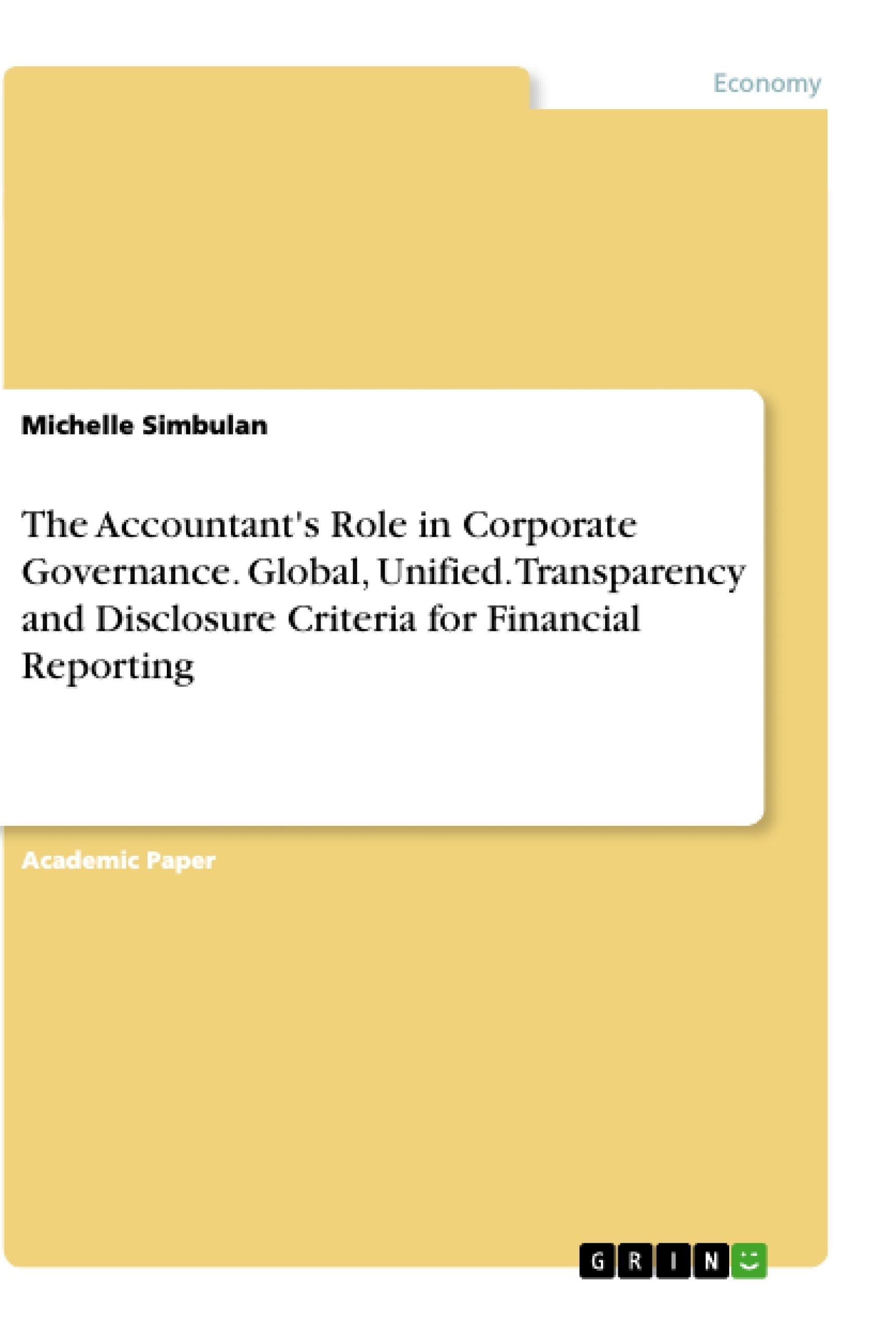This study investigated the principles and criteria for transparency and disclosure in financial reporting and the accountant’s contribution facilitating its implementation. Corporate governance stands upon several principles, raised from the Cadbury report, Principles of Corporate Governance, and Sarbanes-Oxley Act of 2002. It includes rights and equitable treatment of shareholders, interests of stakeholders, role and responsibilities of the board, integrity and ethical behavior, and disclosure and transparency.
Disclosure and transparency are one of the principles of corporate governance that aims to inform the public of the roles and responsibilities of the board and management in order to provide stakeholders with a level of accountability. It also includes the implementation of procedures to independently verify and safeguard the integrity of the company’s financial reporting..
Inhaltsverzeichnis (Table of Contents)
- ABSTRACT
- INTRODUCTION
- Rationale of the Study
- THE PROBLEM
- Statement of the Problem
- SIGNIFICANCE OF THE STUDY
- DEFINITION OF TERMS
- THEORETICAL BACKGROUND
- REVIEW OF RELATED LITERATURE
- Transparency and Disclosure
- Global, unified financial reporting disclosure
- The evolution of the role of accountants
- CONCEPTUAL FRAMEWORK
- RESEARCH METHODOLOGY
- RESEARCH ENVIRONMENT
- RESEARCH RESPONDENTS
- RESEARCH INSTRUMENT
- RESEARCH PROCEDURES
- CHAPTER 4
- PRESENTATION, ANALYSIS, AND INTERPRETATION OF DATA
- SUMMARY, CONCLUSION AND RECOMMENDATION
- FINDINGS OF THE STUDY
- CONCLUSIONS
- RECOMMENDATIONS
- REFERENCES
- APPENDICES
- The extent of practice in transparency and disclosure of financial information in terms of accuracy, consistency, appropriateness, completeness, clarity, timeliness, convenience, governance, and enforcement.
- The application of criteria for transparency and disclosure of financial information in the Philippine setting, with a focus on related party transactions, audit committee financial expert disclosure, and annual financial reports.
- The role of accountants in enhancing transparency and disclosure towards a more effective corporate governance, particularly in the context of the ASEAN integration.
- The significance of transparency and disclosure as a principle of corporate governance in developing countries.
- The impact of globalized economies and financial flows on the need for increased transparency and disclosure in business practices.
Zielsetzung und Themenschwerpunkte (Objectives and Key Themes)
This study investigates the principles and criteria for transparency and disclosure in financial reporting, specifically focusing on the accountant's role in facilitating its implementation in the Philippine context. It aims to assess the current practices of transparency and disclosure in the country, considering the upcoming ASEAN integration and the global shift towards unified standards.
Zusammenfassung der Kapitel (Chapter Summaries)
The study begins with an introduction that outlines the rationale behind the research and the importance of transparency and disclosure in corporate governance, particularly in developing countries. It discusses the increasing globalization and its impact on business practices, emphasizing the need for improved transparency and accountability. The introduction also highlights the role of accountants in facilitating transparency and disclosure.
The study then delves into the problem, specifically investigating the extent of practice in transparency and disclosure of financial information in terms of various criteria such as accuracy, consistency, and timeliness. It also examines the application of these criteria in the Philippine setting, considering related party transactions, audit committee financial expert disclosure, and annual financial reports.
The research methodology section outlines the methods employed in the study, including the descriptive method, survey questionnaires, open-ended questions, and qualitative analysis. It also describes the research environment, respondents, instrument, and procedures.
Chapter 4 presents the analysis and interpretation of the collected data, providing insights into the extent of transparency and disclosure practices in the Philippines. The chapter also explores the role of accountants in promoting transparency and disclosure and their contributions to the implementation of these principles.
Schlüsselwörter (Keywords)
The primary keywords and focus topics of the study are transparency, disclosure, financial reporting, corporate governance, accountants, ASEAN integration, developing countries, global standards, and related party transactions. The study examines the application and effectiveness of transparency and disclosure criteria in the Philippine context, particularly in preparation for the upcoming ASEAN integration. It also emphasizes the role of accountants in enhancing transparency and disclosure as a means of promoting effective corporate governance.
- Quote paper
- Michelle Simbulan (Author), 2021, The Accountant's Role in Corporate Governance. Global, Unified. Transparency and Disclosure Criteria for Financial Reporting, Munich, GRIN Verlag, https://www.grin.com/document/1143192



